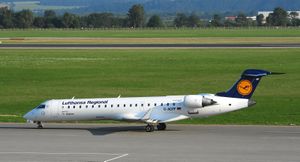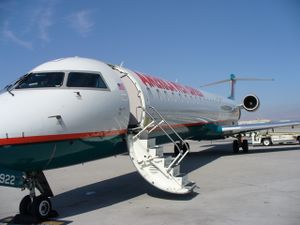PlaneSpottingWorld welcomes all new members! Please gives your ideas at the Terminal.
Bombardier CRJ700/900
| CRJ700 / CRJ900 / CRJ1000 | |
|---|---|
| A CRJ-700 in Delta Connection colors | |
| Type | Regional jet |
| Manufacturer | Bombardier Aerospace |
| Maiden flight | 1999 |
| Status | In production |
| Unit cost | US$24-39.7m as of 2006 |
| Developed from | Bombardier CRJ100/200 |
The Bombardier CRJ700, CRJ900, and CRJ1000 are regional airliners based on the successful Bombardier CRJ200. Final assembly of the aircraft is at Montréal-Mirabel International Airport near Montreal, Québec.[1]
Contents
Development
Following the success of the CRJ-100/-200 series, Bombardier decided to go ahead with the production of larger variants in order to compete with small airliners such as the Boeing 717, the Boeing 737-600, the Embraer E-Jets and similar.
CRJ700

The CRJ700 is a stretched 70-seat version equipped with the General Electric CF34-8C1 engine. Maximum speed is Mach .85 at a maximum altitude of 41,000 feet (12,500 m). Depending upon payload, the CRJ-700 can travel up to 2250 statute miles (3,600 km) with current engines, and a new variant with CF34-8C5 engines will be able to travel up to 2895 miles (4,660 km). The CRJ700 features a new wing with leading edge slats and a stretched and slightly widened fuselage, with a lowered floor. This enables the aircraft to carry up to 78 passengers with a crew of 2 plus cabin crew. The first flight was in 1999 and it entered service in 2001. Competes loosely with the Embraer 170. The CRJ700 comes in three subvariants - Series 700, Series 701 and Series 702. The 700 is limited to 68 passengers, the 701 to 70 passengers and the 702 to 78 passengers. The aircraft's FAA Type Certificate designation is the CL-600-2C10.[2]
CRJ705
The Series 705 is based on the CRJ900, with a business class and a reduced maximum seating capacity to allow operation with scoped regional airlines. Some regional airlines have contracts with their major airlines that limit the maximum passenger capacity of aircraft they operate. Air Canada Jazz was the launch customer for this aircraft in 2005 with 10 executive (business) class and 65 economy seats. The FAA Type Certificate designation of the CRJ705 is the CL-600-2D15.
In August 2006 a total of 260 CRJ700 aircraft (all variants) are in airline service, with 29 further firm orders. Major operators include Lufthansa CityLine (20), American Eagle Airlines (25), Atlantic Southeast Airlines (35), Comair (15), Horizon Air (21), Mesa Airlines (18), PSA Airlines (14), Air Canada Jazz (15), and SkyWest Airlines (57). Some 9 other airlines operate the type, but in smaller numbers.[3]
CRJ900
Stretched 86-seat version (in a single class cabin), with the GE CF-348C5 engines, Template:Convert thrust with APR, and added leading edge slats. Max GTOW is 82,500 pounds.The airplane is loosely based on the CRJ200 series with a few major improvements. The environmental packs have a target temperature instead of a hot-cold knob. The cabin has a recirc fan which aids in cooling and heating. The engines are controlled by FADEC digital engine control instead of control cables and a fuel control unit. The cabin floor has been lowered 2 inches which gains outward visibility from the windows in the cabin as the windows become closer to eye level height. The APU is a General Electric unit which supplies much more air to the AC packs and has higher limits for starting and altitude usage. The wingspan is longer, the tail is redesigned with more span and anhedral. In typical service the CRJ-900 can cruise 8-10,000 ft higher with a slightly higher fuel burn and an average true airspeed of 450-500 knots, a significant improvement over its predecessor. The FAA Type Certificate designation of the CRJ900 is the CL-600-2D24.
Currently Mesa Airlines, SkyWest, Northwest Airlink (Mesaba Airlines), Air Canada Jazz, and Delta Connection (Comair) operate the CRJ900 in North America. The first CRJ900 (N901FJ) was actually a CRJ700 with a longer fuselage plug fore and aft. It sits in Tucson, AZ, with only the flight test and ferry time on it. The CRJ900 competes loosely with the Embraer 175, and according to Bombardier is more efficient per seat-mile. The Embraer airliners have significantly more payload, range and a roomier cabin.
In June 2007 a total of 62 CRJ900 aircraft are in airline service, with 36 further firm orders. Major operators include Mesa Airlines (38) its launch customers, SkyWest Airlines (17) and Atlas Jet (3).[3]
Comair, flying as Delta Connection, has ordered 14 CRJ-900s, with at least 6 in service as of Nov 2007.[4] These are of interest as they are in a two class configuration, with 12 first class seats and 64 coach seats. This is due to a limitation in Delta's contract with its pilots which limits its regional carriers to flying 76-seat aircraft.
CRJ1000
On 19 February 2007, Bombardier launched the CRJ1000, previously designated CRJ900X, as a stretched CRJ900, with up to 100 seats. The aircraft is scheduled to enter service in late 2009. Bombardier claims that it offers better performance and a higher profit per seat than the competing Embraer E-190.
MyAir has ordered 15 CRJ-900X's converted to the CRJ1000.[5] Atlasjet has also indicated interest in the new type.[3] There are currently 38 firm orders and 23 options for the aircraft.[6]
Operators
North America

South America
Europe
Asia
South Asia
East Asia
Africa
- Libya
- Nigeria
- South Africa
- SA Express (a subsidiary feeder airline of South African Airways)
- Tunisia
Specifications
| Variant | CRJ-700 (Series 701) |
CRJ-700 (Series 705) |
CRJ-900 | CRJ-1000 |
|---|---|---|---|---|
| Crew | 4 (2 pilots + flight attendants) | |||
| Seating capacity | 70 | 75 | 86 | 100-104 |
| Length Wing span Height |
32.51 m (106 ft 8 in) 23.24 m (76 ft 3 in) 7.57 m (24 ft 10 in) |
36.40 m (119 ft 4 in) 24.85 m (81 ft 6 in) 7.51 m (24 ft 7 in) |
39.13 m (128 ft 4.7 in) 26.18 m (85 ft 10.6 in) 7.13 m (23 ft 4.8 in) | |
| Engines (2x) Takeoff thrust (2x) Thrust APR (2x) |
GE CF34-8C1 56.4 kN (12,670 lbf) 61.3 kN (13,790 lbf) |
GE CF34-8C5 58.4 kN (13,123 lbf) 63.4 kN (14,255 lbf) |
GE CF34-8C5A1 60.63kN (13,630 lbf) | |
| Max Zero Fuel Weight (ZFW) | 28,801 kg (63,495 lb) | 31,751 kg (70,000 lb) | 35,154 kg (77,500 lb) | |
| Max payload weight | 8,527 kg (18,800 lb) | 10,319 kg (22,750 lb) | 12,156 kg (26,800 lb) | |
| Maximum range | 3,121 km (1,939 mi) ER: 3,676 km (2,284 mi) |
3,591 km (2,231 mi) ER/LR: 3,773 km (2,344 mi) |
2,956 km (1,837 mi) ER: 3,408 km (2,117 mi) LR: 3,660 km (2,274 mi) |
2,761 km (1,491 mi) ER: 3,131 km (1,691 mi) |
| Basic cruising speed | Mach 0.78 (810 km/h, 503 mph) | Mach .80 (838 km/h, 521 mph) | Mach .82 (877 km/h, 545 mph) | |
| Flight ceiling | 12,496 m (41,000 ft) | |||
| Number of Orders | 253 | 168* | 38 23 Options | |
| Certification Date | Dec 2000 | Sept 2002 | 4th Quarter 2009 | |
- Information on CRJ-1000 subject to change.
- Number of Orders for series 705 and CRJ-900 are combined.
CRJ-700:
Dimensions:
- Wing area (net) 760 sq ft 70.61 m²
- Fuselage maximum diameter 8 ft 10 in 2.69 m
- Turning Circle 75 ft 22.86 m
CRJ-900
Dimensions:
- Wing area (net) 760 sq ft 70.61 m²
- Height overall 24 ft 7 in 7.51 m
References
- ↑ http://www.aeroindianews.com/bombardier.htm
- ↑ FAA Type Certificate
- ↑ 3.0 3.1 3.2 Flight International, 3-9 October 2006
- ↑ Comair - Flying First Class with New Aircraft. Comair.com. Accessed 26 November 2007.
- ↑ Bombardier Aerospace Launches 100-Seat CRJ1000 Regional Jet. Bombardier.com. Accessed 19 February 2007.
- ↑ http://www.bombardier.com/en/3_0/3_1/pdf/CRJ_april_30_07.pdf
The initial version of this article was based on a public domain article from Greg Goebel's Vectorsite.
External links
See also
Related development
Comparable aircraft
- ACAC ARJ21
- Antonov An-148
- BAe 146
- Embraer E-Jets
- Fairchild-Dornier 728 family
- Fokker 100
- Mitsubishi MRJ
- Sukhoi Superjet 100
Related lists
See also
Template:Bombardier Aerospace
Lists relating to aviation | |
|---|---|
| General | Timeline of aviation · Aircraft · Aircraft manufacturers · Aircraft engines · Aircraft engine manufacturers · Airports · Airlines |
| Military | Air forces · Aircraft weapons · Missiles · Unmanned aerial vehicles (UAVs) · Experimental aircraft |
| Notable incidents and accidents | Military aviation · Airliners · General aviation · Famous aviation-related deaths |
| Records | Flight airspeed record · Flight distance record · Flight altitude record · Flight endurance record · Most produced aircraft |


